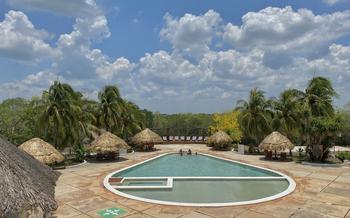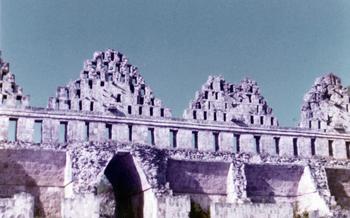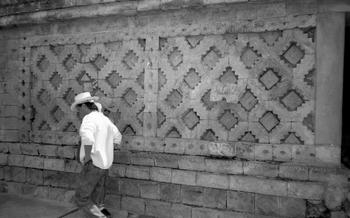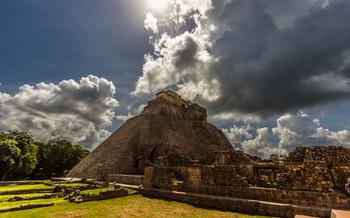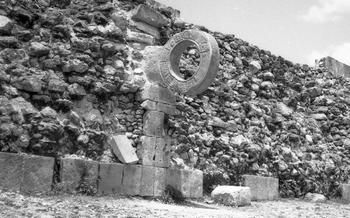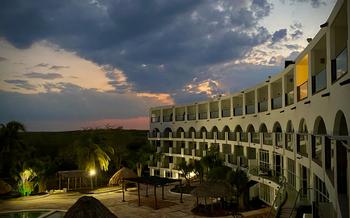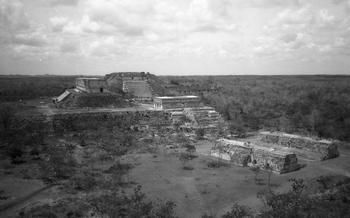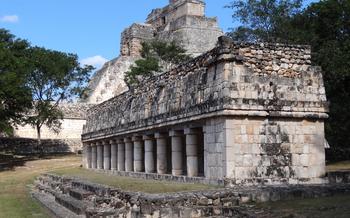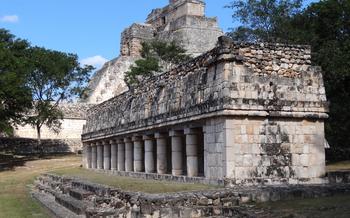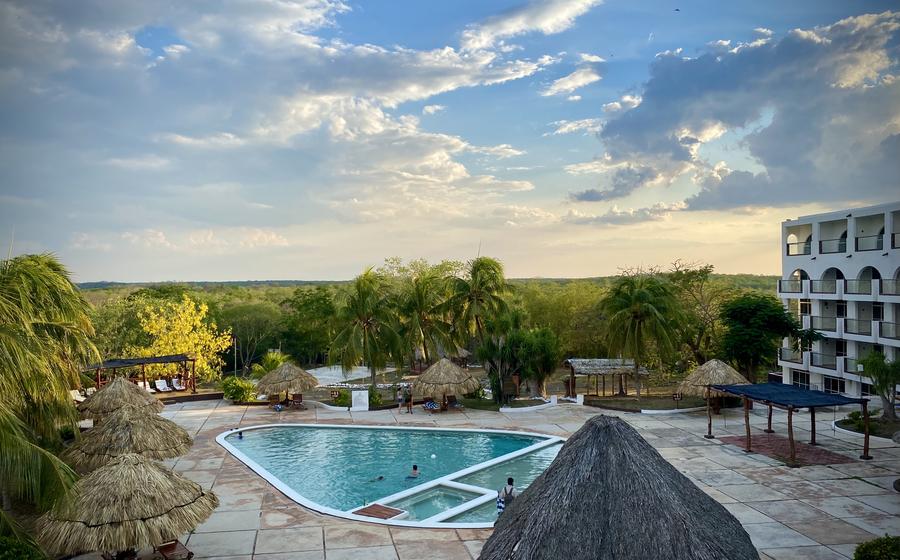
Xpujil Ruins
- Uxmal: A Majestic Mayan City in the Heart of Yucatan
- Exploring the Ruins of Xpujil: A Journey Through Time
- The Governor's Palace: A Symbol of Power and Prestige
- The Pyramid of the Magician: A Masterpiece of Mayan Construction
- The Nunnery Quadrangle: A Complex of Sacred Spaces
- The Ball Court: A Place of Ritual and Competition
- The Temple of the Birds: A Haven for Avian Deities
- The House of the Turtles: A Glimpse into Mayan Daily Life
- The Stelae and Altars: Windows into the Past
- The Museum of Uxmal: Unveiling the Secrets of the Past
- Immersive Experiences at Uxmal: A Journey Through Mayan Culture
- Photography and Social Media: Capturing the Essence of Uxmal
- Insider Tip: Unveiling Hidden Gems
Uxmal: A Majestic Mayan City in the Heart of Yucatan
Uxmal, a majestic ancient city nestled in the heart of the Yucatan Peninsula, Mexico, stands as a testament to the ingenuity and artistry of the Mayan civilization. Once a thriving metropolis, Uxmal played a pivotal role in the political and cultural landscape of the Mayan world. Its well-preserved ruins, adorned with intricate carvings and imposing structures, offer a glimpse into the grandeur and splendor of this once-mighty city.
Location and accessibility: Uxmal is conveniently located in the Puuc region of Yucatan, approximately 62 miles (100 kilometers) south of Merida, the capital city of the state. The site is easily accessible by car or guided tour, making it a popular destination for travelers seeking to explore the wonders of the Mayan civilization.
Best time to visit: The best time to visit Uxmal is during the dry season, which runs from November to April. During this period, the weather is generally pleasant, with warm days and cool nights, making it ideal for exploring the ruins. The rainy season, from May to October, brings lush vegetation and occasional showers, but it can also be hot and humid.
Exploring the Ruins of Xpujil: A Journey Through Time
The Xpujil ruins, located in the heart of the Puuc region, offer a captivating glimpse into the ancient Mayan civilization. Once a thriving city, Xpujil was a cultural and political center that played a significant role in the region's history. Today, the ruins stand as a testament to the architectural prowess and cultural achievements of the Maya.
As you step into the archaeological site, you will be greeted by the remnants of a once-grand city. The ruins are spread over a vast area, with towering pyramids, intricate temples, and residential complexes. The most impressive structures include the Palace of the Governor, the Pyramid of the Magician, and the Great Pyramid.
The Palace of the Governor, with its elaborately carved facades and intricate sculptures, showcases the artistic mastery of the Maya. The Pyramid of the Magician, known for its unique architectural style and construction techniques, is a testament to the engineering prowess of this ancient civilization. The Great Pyramid, the tallest structure in Xpujil, stands as a symbol of Mayan power and grandeur.
Exploring the ruins of Xpujil is like embarking on a journey through time. Each structure tells a unique story, offering insights into the lives, beliefs, and customs of the ancient Maya. The intricate carvings, sculptures, and inscriptions provide a glimpse into their cultural heritage and artistic traditions.
The Governor's Palace: A Symbol of Power and Prestige
The Governor's Palace, also known as the Palace of the Governors, stands as a testament to the power and prestige of Uxmal's rulers. This grand edifice showcases exquisite Mayan architecture and craftsmanship, leaving visitors in awe of its grandeur.
The palace features a series of interconnected rooms and courtyards, each adorned with intricate carvings and sculptures. The exterior facade is adorned with intricate geometric patterns, while the interior walls are adorned with colorful murals depicting scenes from Mayan mythology and history.
One of the most striking features of the Governor's Palace is its grand staircase, which leads to a spacious platform overlooking the central plaza. The staircase is flanked by two colossal serpent heads, symbolizing the power and authority of the rulers who once resided here.
The palace also boasts several chambers, each with its own unique purpose. The Throne Room, with its elaborate throne and intricate carvings, was likely used for important ceremonies and meetings. The Council Chamber, with its long rows of benches, was probably used for discussions and decision-making.
The Governor's Palace offers a glimpse into the lives of Uxmal's elite and provides a tangible connection to the rich history and culture of the Maya civilization.
The Pyramid of the Magician: A Masterpiece of Mayan Construction
The Pyramid of the Magician, also known as the Pyramid of the Dwarf, is one of the most iconic structures in Uxmal. Its unique architectural style and construction techniques make it a masterpiece of Mayan engineering. Standing at an impressive height of 35 meters, the pyramid boasts a five-level design with steep sides and rounded corners. The pyramid's exterior is adorned with intricate carvings and sculptures, showcasing the artistic prowess of the Mayan people.
The Pyramid of the Magician is believed to have been built in the 7th century AD. Its construction involved a series of complex techniques, including the use of cut stone blocks and a corbelled arch system. The pyramid's precise alignment with astronomical events, such as the summer and winter solstices, demonstrates the advanced knowledge of the Mayans in astronomy and mathematics.
Inside the pyramid, archaeologists have discovered a series of chambers and tunnels, including a burial chamber containing the remains of an important Mayan ruler. The pyramid's interior also features a number of impressive murals and paintings, which provide valuable insights into Mayan mythology and religious beliefs.
The Nunnery Quadrangle: A Complex of Sacred Spaces
Among the remarkable structures at Uxmal, the Nunnery Quadrangle stands out as a complex of interconnected buildings that served religious purposes. Its name is misleading as there is no evidence of nuns residing here. Instead, it was likely used by priests and other religious figures for ceremonies and rituals.
The quadrangle comprises four buildings arranged around a central courtyard, with each building featuring multiple chambers and doorways. The architectural style is characterized by corbelled vaults, intricate stone carvings, and decorative friezes depicting Mayan deities and mythological scenes.
The most prominent structure within the quadrangle is the Temple of the Phalli, named for the phallic symbols adorning its facade. These symbols represent fertility and regeneration, reinforcing the quadrangle's association with religious ceremonies.
The Nunnery Quadrangle's significance lies in its function as a sacred space where Mayan priests performed rituals and ceremonies. It was likely used for religious gatherings, prayers, and offerings to the gods. The intricate carvings and decorations within the quadrangle provide valuable insights into Mayan religious beliefs and practices.
The Ball Court: A Place of Ritual and Competition
Amidst the ruins of Uxmal, the ball court stands as a testament to the significance of the ancient Maya game of pok-ta-pok. This ritualistic sport held deep cultural and religious meaning for the Maya, and the ball court at Uxmal is one of the largest and most impressive in the Maya world.
Measuring an impressive 115 meters in length and 68 meters in width, the ball court features two parallel walls with sloping sides. At the center of each wall, a stone ring is embedded, serving as the target for the players. The game was played with a solid rubber ball, and the objective was to hit the ball through the stone rings.
Pok-ta-pok was more than just a game; it held profound religious and symbolic significance for the Maya. It was believed that the outcome of the game could influence the fate of the community, and the players were often seen as representatives of the gods. The game was also associated with fertility and rain, and it was often played during important festivals and rituals.
Today, visitors to Uxmal can still marvel at the grandeur of the ball court and imagine the excitement and intensity of the ancient games that took place here. It is a reminder of the rich cultural and spiritual traditions of the Maya civilization.
The Temple of the Birds: A Haven for Avian Deities
Amidst the grand structures of Uxmal, the Temple of the Birds stands out with its unique architectural style and profound symbolism. Its design is characterized by intricate carvings depicting various bird species, reflecting the sacred status of birds in Mayan mythology. The temple served as a place of worship and veneration for avian deities, who were associated with fertility, rain, and the afterlife.
The temple's facade is adorned with an array of bird sculptures, including owls, parrots, and hawks. These carvings showcase the exceptional craftsmanship of the Maya and their deep connection to the natural world. The interior of the temple features a series of chambers and passageways, each decorated with bird motifs and hieroglyphs that tell stories of creation and the divine.
One of the most notable features of the Temple of the Birds is its central chamber, which houses a large altar dedicated to the Mayan bird god Itzamna. Itzamna was considered the creator of the world and the patron of agriculture, medicine, and knowledge. Offerings of food, incense, and precious objects were made to Itzamna in this sacred space, seeking his favor and protection.
Visiting the Temple of the Birds is a truly immersive experience that transports visitors back in time to the days when the Maya revered the power and beauty of the avian world. The temple's intricate carvings, serene atmosphere, and historical significance combine to create a profound sense of wonder and awe, leaving visitors with a lasting appreciation for the rich cultural heritage of the Maya.
The House of the Turtles: A Glimpse into Mayan Daily Life
Amidst the grandeur of Uxmal's ceremonial and religious structures, the House of the Turtles offers a glimpse into the daily life and domestic sphere of the ancient Maya. This modest structure, located near the Nunnery Quadrangle, served as a residential building, providing insights into the living arrangements and customs of the Maya.
Distinguished by its rectangular shape, the House of the Turtles features thick walls, a thatched roof, and a series of narrow doorways and windows. Inside, the house is divided into several rooms, each serving a specific purpose. Living quarters, storage areas, and cooking spaces are arranged in a practical and efficient manner, showcasing the Maya's ingenuity in designing functional living spaces.
The most striking feature of the House of the Turtles is its intricate carvings depicting turtles, a symbol of fertility and longevity in Mayan culture. These carvings adorn the lintels above the doorways and windows, adding an artistic touch to the otherwise simple facade. The turtles' presence suggests that this house was likely inhabited by a family or clan, emphasizing the importance of familial bonds in Mayan society.
Exploring the House of the Turtles is like stepping back in time and witnessing the domestic life of the Maya. The structure provides a tangible connection to the daily routines and customs of this ancient civilization, offering a glimpse into their world beyond the grand temples and palaces.
The Stelae and Altars: Windows into the Past
Scattered throughout Uxmal, intricate stelae and altars provide valuable insights into the city's history, culture, and religious beliefs. These monolithic monuments, carved from limestone, often depict rulers, deities, and significant events. The inscriptions and carvings on these stelae and altars offer a glimpse into the lives of the ancient Maya, their political structure, and their complex religious system. Archaeologists have meticulously studied these inscriptions, deciphering the Mayan hieroglyphs to reveal the names of rulers, dates, and historical events. These stelae and altars serve as windows into the past, offering a tangible connection to the thoughts, beliefs, and practices of the ancient Maya civilization.
The Museum of Uxmal: Unveiling the Secrets of the Past
Nestled within the archaeological site of Uxmal, the Museum of Uxmal stands as a treasure trove of Mayan history and culture. This modern facility houses a captivating collection of artifacts and exhibits that provide visitors with a deeper understanding of this ancient civilization.
The museum's display halls showcase a diverse range of relics, including intricate stone sculptures, ceramic vessels, and jewelry. These artifacts offer a glimpse into the daily lives, beliefs, and artistic traditions of the Maya. Visitors can marvel at the intricate carvings depicting Mayan deities, mythological creatures, and scenes from everyday life.
One of the highlights of the museum is its collection of stelae, which are carved stone monuments. These stelae are inscribed with hieroglyphs that provide valuable historical information, such as the names and dates of Mayan rulers, their conquests, and their lineage. They also shed light on the political and social structure of the Mayan civilization.
The Museum of Uxmal also features interactive exhibits that bring the ancient Maya to life. Visitors can learn about Mayan astronomy, mathematics, and writing systems. They can also experience a virtual reality tour of the site, providing a unique and immersive perspective of Uxmal's grandeur.
A visit to the Museum of Uxmal is an essential complement to exploring the ruins themselves. It offers a comprehensive overview of Mayan history and culture, allowing visitors to delve deeper into the mysteries of this ancient civilization.
Immersive Experiences at Uxmal: A Journey Through Mayan Culture
Uxmal offers a variety of immersive experiences that transport visitors back in time and allow them to connect with the rich Mayan culture. Traditional dance performances showcase the vibrant colors, rhythmic movements, and captivating storytelling of ancient Mayan traditions. These performances often take place in the heart of the ruins, providing a breathtaking backdrop for a truly unforgettable experience.
For those seeking a more hands-on encounter, Mayan cultural workshops offer the opportunity to learn traditional crafts, such as weaving, pottery, and woodcarving. These workshops are led by local artisans who share their skills and knowledge, providing visitors with a unique glimpse into the artistic heritage of the Maya.
Storytelling and legends are an integral part of Mayan culture, and Uxmal offers visitors the chance to delve into these captivating tales. Guided tours often include storytelling sessions, where guides share ancient myths, legends, and historical accounts that bring the ruins to life and offer a deeper understanding of Mayan beliefs and traditions.
Photography and Social Media: Capturing the Essence of Uxmal
Uxmal's majestic ruins offer a wealth of opportunities for capturing breathtaking photographs. To ensure stunning shots, consider using a wide-angle lens to capture the scale and grandeur of the structures. Experiment with different angles and perspectives to create unique and dynamic compositions. The golden hours of sunrise and sunset bathe the ruins in a warm, ethereal light, creating magical photo opportunities.
Share your Uxmal experiences with the world through social media. Use relevant hashtags such as #Uxmal, #MayanRuins, and #Yucatan to connect with other travelers and enthusiasts. Platforms like Instagram and Facebook offer excellent opportunities to showcase your photos and share your travel stories. Tag @UxmalOfficial and @VisitMexico to get featured and connect with the official tourism boards.
Join the vibrant online community of Uxmal lovers by following local influencers, photographers, and travel bloggers who share their experiences and insights about the site. Engage with their content, ask questions, and share your own perspectives. By actively participating in the social media conversation, you'll enhance your Uxmal experience and connect with like-minded individuals.
Insider Tip: Unveiling Hidden Gems
While Uxmal and Xpujil are undoubtedly captivating, the Puuc region holds a treasure trove of lesser-known ruins that offer a glimpse into the rich history and architectural prowess of the ancient Maya. Scattered throughout the region, these hidden gems await exploration.
Off the beaten path, you'll find sites like Kabah, with its impressive Palace of the Masks, and Sayil, featuring a grand palace and intricate carvings. Each ruin tells a unique story, showcasing the diverse architectural styles and artistic traditions of the Maya.
To fully immerse yourself in the local culture, venture into the vibrant markets of nearby towns and villages. Here, you'll discover a symphony of colors, aromas, and flavors as vendors display their handmade crafts, fresh produce, and traditional Yucatecan delicacies.
Indulge in the culinary delights of the region, savoring the flavors of cochinita pibil, a slow-roasted pork dish, and panuchos, a traditional Mayan dish made with tortillas, beans, and meat. These culinary experiences will tantalize your taste buds and provide a deeper connection to the local culture.
Venture beyond the well-trodden paths and uncover the hidden treasures of the Puuc region. Immerse yourself in the rich history, vibrant culture, and authentic flavors of this captivating corner of Mexico. Embrace the spirit of exploration and discover the hidden gems that await those who dare to stray from the beaten path.
